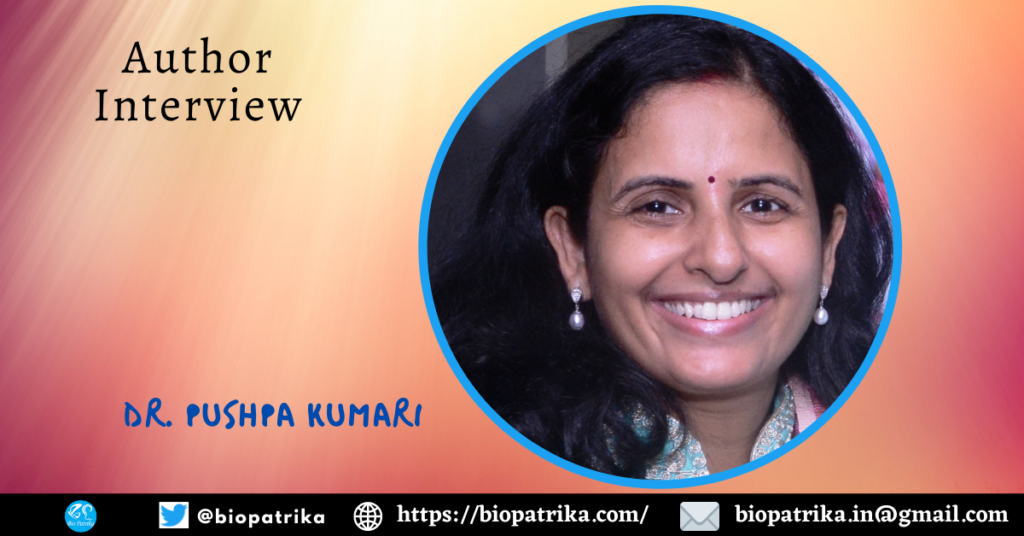About author: Dr. Pushpa Kumari is an example of multicultural India. She studied in various Kendriya Vidyalayas throughout the country for schooling, which helped her explore and understand our country’s diversity and multi-faceted culture. While growing up among different communities and understanding other languages made her know how a particular society thrives and ignited her interest in understanding the mechanics of diverse living systems. She completed her formal integrated bachelor’s degree (B.Sc-B.Ed), where she gained knowledge of plant and animal systems. She understood how chemistry works in its way into these living systems while getting trained to become a professional teacher. As fate had it, she went on to pursue her Master’s degree in Biotechnology from Ramachandra Medical College and Research Institute, Chennai, which helped her strengthen her basic foundation in biomedical science. She further pursued her career in Developmental Biology under the Supervision of Dr. K. Subramaniam – one of the pioneers of the Caenorhabditis elegans (roundworm) model system in India – at the Indian Institute of Technology Kanpur. Pushpa was awarded Junior Research Fellowship from CSIR and a National Doctoral Fellowship from AICTE. After completing her Ph.D. in biological sciences, she developed a research interest. She further followed her career in cell and developmental biology and became a Post-Doctoral fellow with Dr. Sivaram Mylavarapu at the Regional Centre for Biotechnology Faridabad. She won her first independent research grant as an Early Career Fellowship from the DBT/Wellcome India Alliance. Pushpa Kumari, in the future, wants to pursue her career in academic research and contribute to the field of Reproductive Biology.
How would you explain your research outcomes to the non-scientific community?
Our study provides insight into the cell division of the stem cells that form sperms and oocytes (gametes). Regulated proliferation of the gamete-forming germline stem cells (GSCs) is essential for fertility and continuity of species for any sexually reproducing organism. We found a crucial role of a protein machinery in the cell that regulates intracellular transport, the Exocyst complex, in depositing the optimum number of the key signaling receptor (Notch) on the surface of the cell. This process ultimately controls gamete numbers and fertility, since Notch is responsible for receiving and transmitting the stemness signals from the nearby niche.

How do these findings contribute to your research area?
The role of intracellular trafficking in regulating Notch receptor levels in the signal receiving GSCs was not known. We show that the Exocyst complex collaborates with two major cell trafficking GTPases namely, Rab5 and Rab11, to traffics Notch receptor to the GSC cell surface. Our work provides evidence of a critical role for the Exocyst complex in maintaining the correct cell membrane level of Notch in this stem cell.
What was the exciting moment during your research?
The most exciting moment during this study was when we first observed the effect of removal of the Exocyst complex on the distribution and accumulation of the Notch receptor on the niche-facing cell membrane, and then finding that Notch biochemically interacts with the Exocyst complex. These two observations set the ball rolling for us and the rest fell into place in our story.
Our work provides evidence of a critical role for the Exocyst complex in maintaining the correct cell membrane level of Notch in this stem cell.
What do you hope to do next?
I wish to work further in the field of reproductive biology. I am very invested in causes related to women. A challenge faced by several educated women across class, culture and nations is choosing to reproduce when the age is right (either before 30 or in their early 30s) while being in the prime of their careers. Worldwide, including in India, we are seeing a trend in increased maternal age as more and more women choose to reproduce in the mid or late-30s, which can cause serious fertility issues, increased rate of miscarriages and a higher rate of congenital birth defects with increased dependence on assisted reproductive technology. My future work will focus on the age-associated changes in oocytes in the quest to identify major cellular mechanisms that could then be tweaked to find ways to delay ovarian aging. This will be a major issue in the near future as the birth rates across the world are declining.
Where do you seek scientific inspiration from?
Currently, I draw my scientific inspiration from my two young daughters who teach me how to be open-minded while approaching a problem. I try to never fail to appreciate the failures, because it is all part of the learning process, and rather enjoy the journey of science and discovery. In addition to this, my mentors during my Ph.D. and postdoctoral work have been a huge influence on the way I approach and perform my science.
How do you intend to help Indian science improve?
In my opinion, education is the solution to all of our problems. With education comes the open mindedness to accept alternative views. Therefore, I intend to be a teacher-cum-researcher to enable young minds open up to not just the mysteries of science, but also to the way of thinking and living scientifically and to gain the scientific temperament.
Reference
Kumari Pushpa, Sunayana Dagar, Harsh Kumar, Diksha Pathak and Sivaram V. S. Mylavarapu. The exocyst complex regulates C. elegans germline stem cell proliferation by controlling membrane Notch levels. Development (2021) 148 (15): dev196345.
Edited by: Dolly Singh
